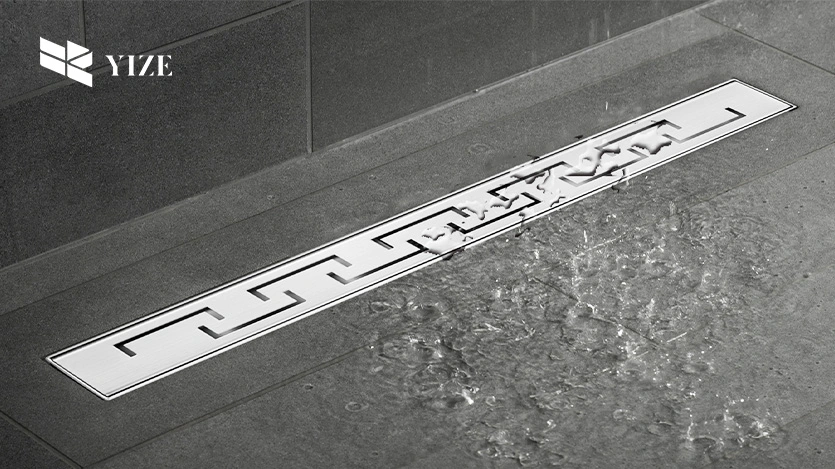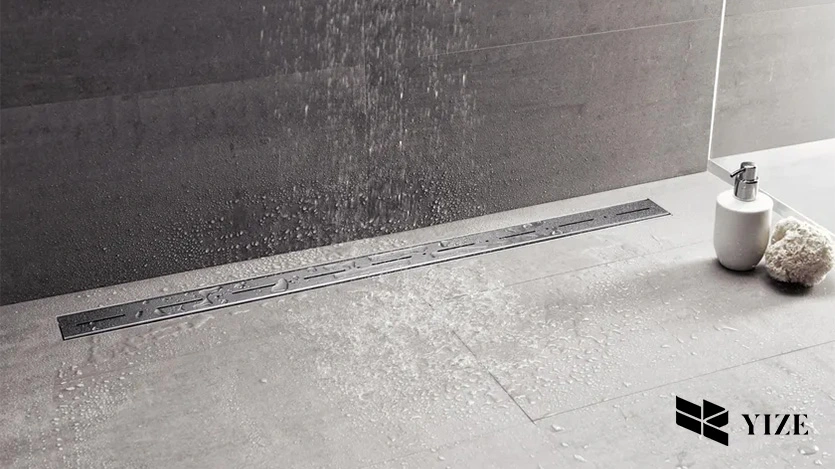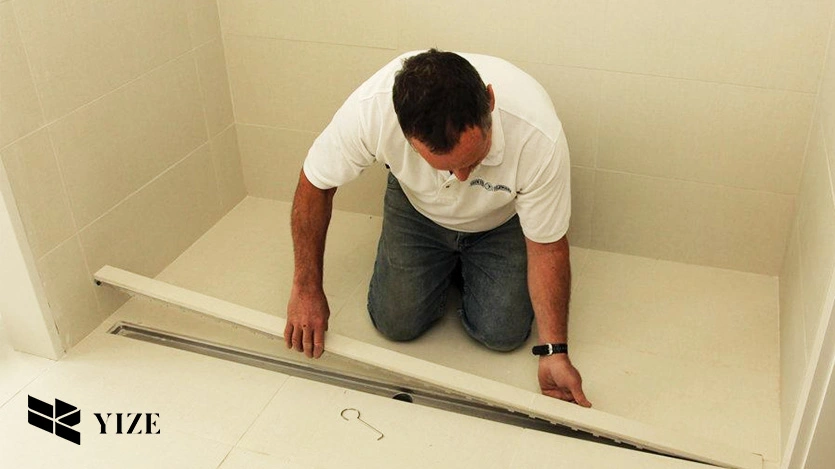
I. Introduction
If properly selected, a drain is designed to let water drain out simply while responding to the contemporary aesthetic design of a bathroom. Linear shower drains are being accepted not only for their smooth looks alone but also because they are capable of handling the water flow completely.
In our basic discussion of this guide, we shall review all the main facets of the choice of the best linear shower drain. We will then consider if it is proper to stage your layout and decide on the dimensions, material, and other features that must be incorporated.
II. Assessing: Is a Linear Shower Drain Ideal for Your Bathroom?
Many people prefer linear shower drains, but come to think of it, is this the right thing to get? So, now that we’ve considered the benefits of drains let’s dwell on their performance compared to traditional drains and the cases when drains are ineffective.
1. Benefits of Linear Shower Drains
Linear shower drains come with several benefits as compared to the center drains.. These include:
- Better Water Flow: Like any other drain system, linear drains can only flow in one direction and are suitable for large shower areas.
- Minimal Sloping: Conventional drains have steep slopes in one way and alternate slopes in another way, whereas linear drains have only one slope and thus have more flexibility in tile selection.
- Modern Aesthetic: The linear drains are elegant and are preferred in contemporary designs.
- Accessibility: It makes it easy to install curbless barrier-free showers, which is much of what is good for anybody who requires easy access.
2. Types of Bathroom Layouts That Work Well with Linear Drains
Linear drains are most effective where the orientation of the bathroom is such that there is a large open area for showers. They are ideal for:
- Walk-in Showers: Another type of drain is linear drains, which are effective in directing water in elaborate walk-in showers.
- Wet Rooms: A linear drain will be beneficial in controlling the flow of water, particularly in a bathroom or wet room with no barrier between the internal and external environment.
- Curbless Showers: It is best to install the linear drains for a smooth floor, no edges entry and makes the bathroom look more sophisticated.
3. Scenarios Where a Linear Drain May Not Be Suitable
Despite their benefits, there are scenarios where a linear shower drain might not be the best option:
- Small Shower Spaces: Linear drains are not ideal in small showers, which should preferably use a center drain.
- Existing Plumbing Constraints: They also pointed out that the nature of a specific plumbing arrangement may not allow for the single slope necessary with a linear drain – and this would be another cost.
4. Factors to Consider
- Existing Plumbing Layout: Before you make a choice about a linear drain, evaluate your existing water system. Will it be integration-friendly, or will there be changes? By involving your plumber at the design phase, you can be assured of compatibility between the two systems.
- Shower Size and Design: Linear drains are highly dependent on the size and shape of the shower, and this tells a lot about it. Extended showers are generally compatible with extended linear drains, but designing around smaller or odd-shaped showers may require some considerable thinking.
- Aesthetic Preferences and Bathroom Style: Consider integrating the linear drain into your bathroom’s existing design. Linear drains come in different finish options, and it is simple to coordinate them with fixtures and tiles.
III. Size: How Do I Determine the Required Length of the Linear Shower Drain?

1. Measuring Your Shower Area Accurately
It would be beneficial for you to know that the process of choosing the correct linear shower drain begins with measuring the shower space. This space is the length of the shower floor in which the drain is to be installed. Measure this space properly so that you may fit the drain properly.
(1)Tips for Ensuring Your Measurements Are Precise
- One should use a measuring tape and make sure to make a correct measurement the first time around.
- Consider any work that may involve finishing and tiling which may eventually alter the dimension of the existing room.
- Finally, when measuring for drains to be placed, consider the slope of the floor as well.
(2)Importance of Considering Drain Placement and Slope
Both positioning and inclination play important roles in water drainage processes. An optimal surface should have a gradient of at least 1-2% to allow free-flowing water towards the drain. The location of the drain, whether at the shower perimeter or at the center, also determines the design of the slope.
2. Standard vs. Custom Lengths
Linear shower drains are available in standard sizes varying from 24 to 60 inches for a series of models. These standard sizes have been proven to fit most shower designs and layouts depending on the patterns used. If your shower area has dimensions that make the shower pan length different from standard sizes, then a customized length shower drain shall be taken. YZDRAIN drains can be individually adjustable in length; in order to purchase a certain length of a drain, one simply has to specify this length. These drains are developed to cater to your bathroom, particularly in an irregular length or width of the shower base.
IV. Key Features to Look for in a Linear Shower Drain
1. Material and Durability
(1)Common Materials Used in High-Quality Linear Shower Drains
In the selection of materials, the best bet should be on those that can easily be maintained and those that are very strong. The most common materials include:
- Stainless Steel: It provides extremely good corrosion protection and sturdiness.
- PVC: it is relatively inexpensive and lightweight, but it is not as strong and durable as stainless steel.
(2)Comparing Durability and Maintenance Requirements of Different Materials
Stainless steel is more durable and does not need much attention compared to PVC, which might need much attention often. If you are interested in a material that is sure to last, then stainless steel should be your go-to when looking for a linear shower drain.
2. Design and Aesthetics
(1)Types of Grate Designs and Finishes Available
There are many kinds of grates that can be incorporated into linear drains, including patterned grates, slotted grates, and tile insert grates that are almost invisible when laid on the shower floor.
(2)How to Match the Drain Design with Your Bathroom Décor
Select a drain style and surface coating that harmonize with your choice of bathroom fixture and flooring tiles. H-barred finishes can be matte or polished, depending on the preferred general outlook.
3. Installation Options and Flexibility
(1)Various Installation Methods: Wall-Mounted, Center, or Edge Installations
Various Installation Methods: This includes wall-mounted installations, which can either be centrally located or installed at the edge of a region.
That being said, linear drains may be put in various positions within the bathroom based on their particular design. Common options include:
- Wall-Mounted: Essential during showers with many changes in wall-to-floor conditions.
- Center Installation: Recommended for large showers especially where a central drain of the system is necessary.
- Edge Installation: Excellent for curbless showers where the drain is installed along one wall of the shower.
(2)Importance of Choosing a Drain That Is Easy to Install and Adjust
A relatively simple-to-install drain is time-saving and cost-effective. Give preference to drains equipped with adjustable legs and possess a rather adjustable installation process—this may come in handy if you decide to install them yourself.
V. Installation Considerations
1. Preparing for Installation
Prior to fixing your linear shower drain, be certain that the floor beneath it is clean, flat, and adequately sealed against water leakage. Preparing the ground correctly eliminates leakage and promotes the drain’s durability.
2. Installing the Linear Shower Drain
Linear drain installation involves the following steps:
- Mark and cutting off the space for the drain.
- Install the drain at the required gradient normally 1-2%.
- Fix the drain to the subfloor.
- There should be good sealing around the drain.
- Tile over the drain and make sure that there are no joints around it.
3. Hiring a Professional vs. DIY
Even though people can install recessed lighting by themselves, getting a professional to work on the project guarantees results. Professionals have the tools and experience to deal with other potential problems, such as improper slope or subfloor.
VI. Why Choose YZDRAIN?

1. High-Quality Standards and Process Technology
YZDRAIN produces quality products from modern production facilities for toughness and reliability.
2. Best Excellent Durability Solutions
YZDRAIN products have features such as these. They are designed to last and offer excellent resistance to wear and tear and worse in wet terrain.
3. Customer Feedback
YZDRAIN has also received lots of positive feedback from various customers due to its high standards, product options, and long-lasting solutions. Such positive feedback gives an inflow of information about the kind of brand that the company is offering to the people and the quality of the brand.
VII. Conclusion
Selecting the right linear shower drain will depend on the style, layout, size of your bathroom, and other plumbing issues. A perfect drain is supposed to perform a good drainage service and possess the best outlook that will enhance the appearance of your bathroom. YZDRAIN provides a large selection of advanced, trendy, and easily adjustable drains that would be ideal for any bathroom design. His products are available at YZDRAIN for reliable and fashionable findings.
Frequently Asked Questions (FAQs)
1. How do I clean and maintain a linear shower drain?
It is necessary to empty the bin from time to time and ensure that no small objects have blocked the room’s drain.
2. Can I install a linear drain in a small shower?
Yes, but depending on the size of the shower, the drain size has to be in proportion to the shower size.
3. What materials are best for linear drains?
Stainless steel is the most durable and thus the most resistant to corrosion material of the three.
